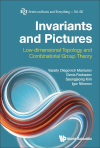- About MAA
- Membership
- MAA Publications
- Periodicals
- Blogs
- MAA Book Series
- MAA Press (an imprint of the AMS)
- MAA Notes
- MAA Reviews
- Mathematical Communication
- Information for Libraries
- Author Resources
- Advertise with MAA
- Meetings
- Competitions
- Programs
- Communities
- MAA Sections
- SIGMAA
- MAA Connect
- Students
- MAA Awards
- Awards Booklets
- Writing Awards
- Teaching Awards
- Service Awards
- Research Awards
- Lecture Awards
- Putnam Competition Individual and Team Winners
- D. E. Shaw Group AMC 8 Awards & Certificates
- Maryam Mirzakhani AMC 10 A Awards & Certificates
- Two Sigma AMC 10 B Awards & Certificates
- Jane Street AMC 12 A Awards & Certificates
- Akamai AMC 12 B Awards & Certificates
- High School Teachers
- News
You are here
Invariants and Pictures: Low-dimensional Topology and Combinatorial Group Theory

Publisher:
World Scientific Publishing
Publication Date:
2020
Number of Pages:
388
Format:
Hardcover
Price:
118.00
ISBN:
978-9811220111
Category:
Monograph
[Reviewed by , on ]
Robert Bell
11/28/2022
Invariants and Pictures is a text aimed at students and researchers who are familiar with classical braids and links and their classical invariants. The book introduces several generalizations of these, many of which were developed by the authors and their collaborators over the past twenty years.
Many such invariants are “picture valued,” e.g., diagrams satisfying a minimality condition. Indeed, as the first author explains in the introduction, one of the fascinating properties of classical knots is that there exist diagrams that represent equivalent knots but which require a sequence of moves through diagrams of greater complexity, e.g., the number of crossings, to realize this equivalence. However, for some generalizations of knots, e.g., free knots, there are picture valued invariants in which reducing the picture or diagram to a minimal state yields an invariant.
Other invariants are valued in certain finitely presented groups where methods of combinatorial group theory are sometimes fruitful. One generalization of braids to which this applies is the following. Classical braids can be studied dynamically as distinct points moving in the plane; indeed the fundamental group of this configuration space is the braid group. If distinct points move in \( R^{3} \), then the fundamental group of this configuration space is trivial. However, instead of studying the entire configuration space, one considers a restricted configuration space where triples of points are not allowed to be collinear. One is led to a finitely presented group \( G^{k}_{n} \), called a \( k \)-free braid group with \( n \) strands in which the generators correspond to k-tuples of points which are singular, e.g., collinear, and relations arise from considering a codimension two singularity such as \( k + 1 \) collinear points that can be resolved into codimension one singularities.
While the invariants are perhaps the goal, the players, that is, the generalizations of knots, take center stage. Two such generalizations receive special attention in the first half of the book: virtual knots and free knots. Both arise naturally via Gauss diagrams. The Gauss diagram of a classical oriented knot consists of a circle with a \( 2n \) distinguished points corresponding to the \( n \) crossings ordered cyclically (and each visited twice) by traversing the oriented diagram and \( n \) oriented chords which connect over crossings to under crossings and which are further decorated by the sign of the crossing. If one draws such a chord diagram without requiring it to be realized by some classical knot, then one discovers virtual knots, which arise naturally by drawing knot diagrams on surfaces. If one drops the orientation and signs that decorate chords, one is led to free knots. The book describes both virtual knots and free knots in considerable detail, emphasizing the combinatorial viewpoint of diagrams and virtual Reidemeister moves. Additionally, state sum invariants such as those which lead to the Jones polynomial of a classical knot are investigated. Unlike the classical case, there is a nontrivial parity invariant, e.g., in a Gauss diagram of a classical knot, each chord intersects an even number of chords, but this restriction vanishes in the study of virtual or free knots.
While the above hopefully provides a general sense of what this book is about, it does not do justice to the breadth of topics. In particular, the authors also discuss cobordisms of (virtual and free) knots, representations of the \( k \)-free knot groups, decision problems in \( k \)-free knot groups, and a higher dimensional generalization of \( k \)-free groups in which triangulations of manifolds and moves between such triangulations, e.g., flipping a diagonal of a square, give relations. This later topic is the subject of Part Four of five. Part Five consists of questions and unsolved problems.
Students and researchers working in knot theory, braid theory, or a related area will find this an accessible introduction to virtual knots and free knots. While most of the proofs are sketched, the serious student will want to read the original articles. The book concludes with an extensive bibliography of the work that has been done in this emerging area of research.
Robert Bell is an Associate Professor at Michigan State University. His research interests include geometric group theory and combinatorial games.
See the publisher's website.
- Log in to post comments




